Article by Rutgers Raritan Scholar Intern Allie Oross

#lookfortheriver
On Saturday, July 7th, the LRWP led the New Brunswick Environmental Commission and other members of the New Brunswick community in a project on the Redmond Street side of Lord Stirling Elementary School. The final product of their hard work is manifested in a whimsical sidewalk mural that not only serves as a form of neighborhood beautification, but also a semi-permanent reminder of the intricate roles human’s play in the environment.
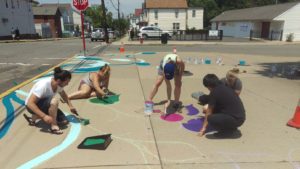
New Brunswick Environmental Commissioners, residents and LRWP friends paint flowers
Funded through an Americorps alumni grant secured by Thalya Reyes, and designed by former Americorps alum Johnny Malpica, interwoven swirls paint a picture of natural necessities that are integral aspects in every single person’s day to day life. In the mural, clouds create rain drops that collect to form a pulsing river. That river then flows into a set of flowers being pollinated by a bee and a butterfly with the next section displaying a fish in the river. Though the images are depicted in a delightfully playful and abstract manner, each can also be interpreted as a representation for a much more crucial concept:
We, as a community and as a species, must never forget how inextricable we are from the environment. You cannot have one without the other, and though we may seem separated from nature, the gap is almost always smaller than we may think.
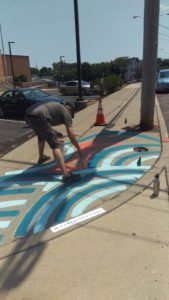
New Brunswick Environmental Commissioner Howie Swerdloff paints a river
A few blocks down from the sidewalk mural is the Raritan River. A core purpose for the mural is to act as an expression of the course stormwater runoff takes through the New Brunswick streets every time it rains. After rain events our streets often serve as veins pumping litter and pollution into the heart of our waterways. Out of sight should never mean out of mind when discussing the environment, and the mural engages citizens to remember there is nature all around us if we only make the effort to search for it.
Article and Photos by Margo Persin, Rutgers Environmental Steward
Internship Diary / June, 2018
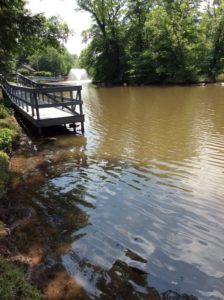
So summer is in full swing – I made a visit to the Ambrose Brook immediately after the summer solstice, on 24 June 2018. The environs have changed in several ways, both passive and active. There are several aerating fountains that spray a cool mist that is distributed by the shifting breezes off the water. The highwater mark on the center island has changed since I last visited, probably because of late spring run-off. But the water has even been higher, as evidenced by the residue on all of the banks, the tree roots that extend into the water, and the low-lying bushes. All are wearing a dusty mud color that gives evidence of water that has since receded. Water flow has significantly strengthened, as is noticeable over the modest waterfall close to Rte. 28. In addition, the rain run-off in the two drains has increased, so that more than a trickle from both of them is observable as it enters the brook after the waterfall.
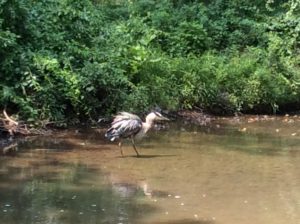
Fauna have increased. One of my prize observations was that of a somewhat lazy or perhaps sleepy but wary blue heron standing on just one leg somewhat in the middle of the stream, past the waterfall. I tried to ease my way in a stealthy and languorous manner along the bank to not call attention to myself, but alas, the heron quickly reacted to my not so subtle approach, was on to me as I slowly worked my way toward the lovely bird . S/he dropped the second leg into the water, turned a cold shoulder in my direction, then deliberately moved away from where I had planted myself on the bank opposite to his/her position. Even though the distance between us stayed about the same, I was so taken by the proximity of this lovely creature and my ability to observe without causing a startled reaction. S/he continued a slow and deliberate saunter down the creek and disappeared around the bend. What a treat to be able to be a silent observer of a stream visitor. Nice!
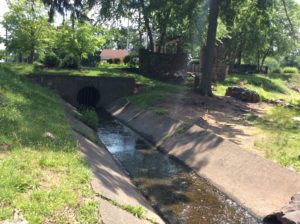
I also noted that the population of Canadian geese has multiplied to a startling extent. And the birds have become so accustomed to human presence that they barely move when a vertical mammal saunters among them, even when they are settled down and roosting on the grass, the available paths or the cement. In order not to encourage their presence, the township has placed signs that pointedly give the command NOT to feed the waterfowl. Obviously, they greatly outnumber any other visitors to this place, either animal or human. And needless to say, mementos and tokens of their presence are all around, some pleasant and others not so much. An addition to the command to not feed the waterfowl would be “Watch your step and be sure to check your shoes before getting in your vehicle.”

Another observation is that butterflies and moths inhabit the environs, with several Monarchs making their graceful presence known as they fluttered past and through my line of vision. Their wingbeats cast a silent beat to the pulse of the planet as they made their way over and through the environs.
Human presence has also increased. It should be noted that the four walkways that run over and parallel to the stream offer an unobstructed view. And all of them are handicap accessible either all or in part. In other words, on all of them ramps are available so that proximity to the stream can be achieved. People who are fishing on the walkways are only part of the traffic. There were several runners, families with tots and strollers, and other quiet observers to finish out the panorama. My next visit in July will be for another stream assessment, boots, thermometer, floating duck, ruler at the ready Happy summer, everyone!
Friends of the Lower Raritan Watershed –
Two weeks ago the NJ Senate passed (by a slim margin) a plastic bag bill (S2600/A3267) backed by industry advocates. That bill is sitting on Governor Murphy’s desk, and he is still considering what action to take on this single-use bag legislation.
This is an awful bill. It will do little to reduce plastic bag use, prohibit municipalities from passing stronger local plastics laws, and direct bag fee funds into the general treasury rather than to pollution reduction.
The Association of New Jersey Environmental Commissions (ANJEC) has created the resolution below for municipalities to offer support for a stronger bill.
The LRWP encourages municipal officials, Green Teams and environmental commissions to customize this resolution and email or snail-mail a signed version to the Governor’s office
E-mail: constituent.relations@nj.gov
Snail mail: Office of the Governor, PO Box 001, Trenton, NJ 08625
PLEDGE of Municipal Support for New Jersey’s Comprehensive Bag Policy
WHEREAS, on average, one person uses 500 single-use disposable bags per year, 4 billion single use shopping bags are used annually in New Jersey and 102 billion are used nationwide; and,
WHEREAS, windblown plastic bags degrade our land and waterways, and 80% of the plastic and trash that finds its way into our oceans comes from the land; and,
WHEREAS, 12 million barrels of oil are used annually to make the plastic bags that Americans use; and,
WHEREAS, according to EPA, seabirds, fish, and other marine and land-based animals mistake plastic for food, while others can become entangled in the trash, leading to exhaustion, starvation, and eventual death; and,
WHEREAS, plastic breaks down into microplastics that measure 5 millimeters or less, which are ingested by shrimp, plankton, fish, birds, turtles, and other sea animals. Microplastics absorb toxic chemicals, harms marine life, and can be consumed by humans via seafood and potable water; and,
WHEREAS, it is beyond dispute that the use of single-use, plastic carryout bags has a severe and negative environmental impact on the local and global environment as a result of the greenhouse gas emissions emitted to produce such bags, the land-based and ocean-based pollution created, the hazards posed to wildlife, the hazards posed to sources of water for humans, and the negative impact on the ecosystem and food chain as a whole; and,
WHEREAS, very few single-use carryout bags are actually recycled (it is estimated that less than 5% of all plastic bags are actually recycled and some estimates are as low as 1%); and,
WHEREAS, the _____________taxpayers currently bear the costs associated with the negative effects of plastic, single-use carryout bags on the solid waste stream, drainage, litter, and the negative consequences of the foregoing environmental impacts; and,
THEREFORE, the town of____________, resolve to support Governor Murphy’s ban on all thin, film plastic bags with a fee on reusable and recycled paper bags.
Agenda and date voted : xx/xx/2018 CERTIFICATION
I hereby certify this is true _______________________________







